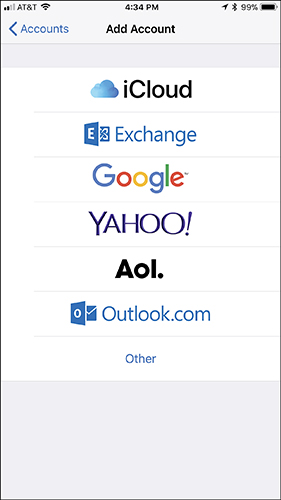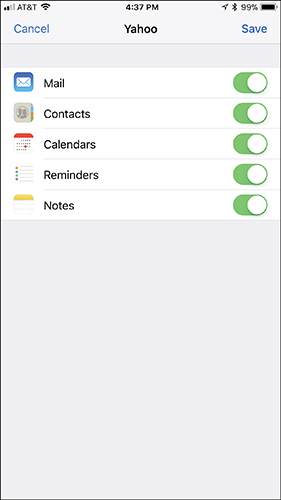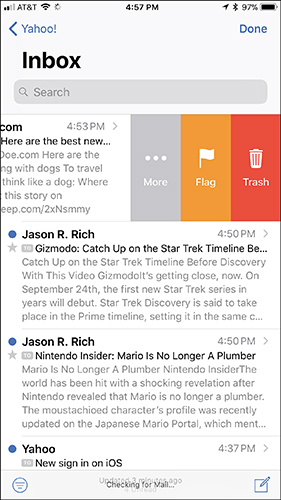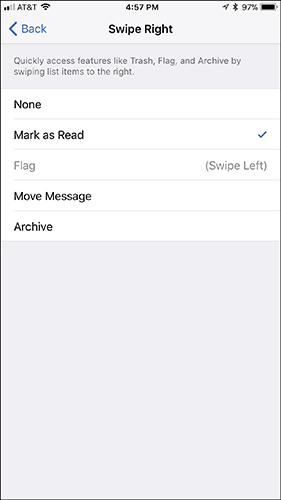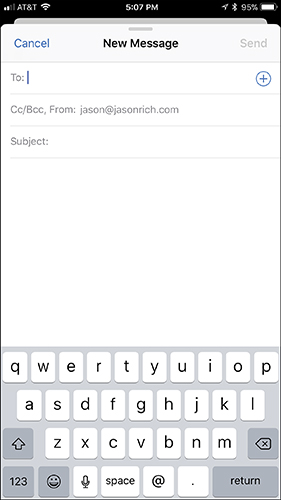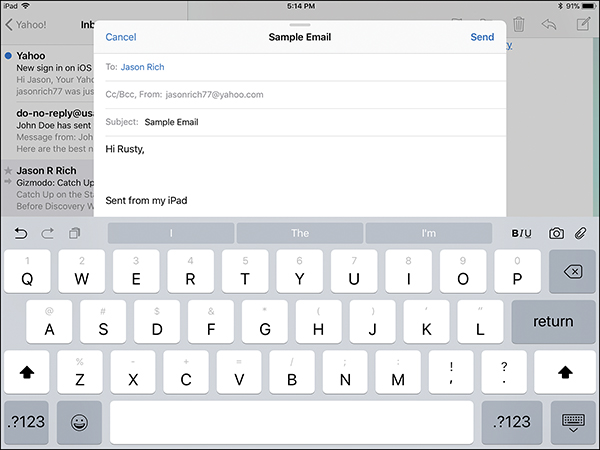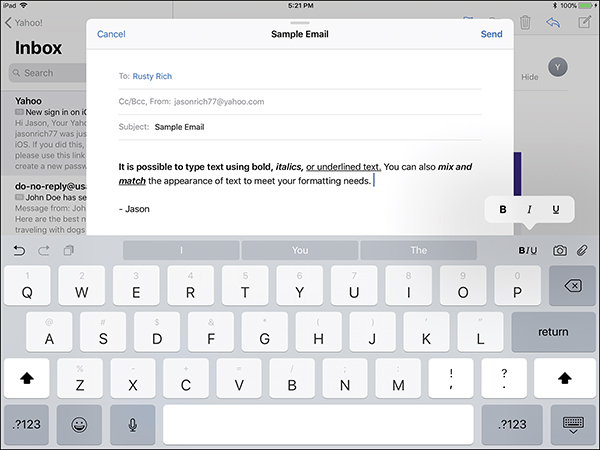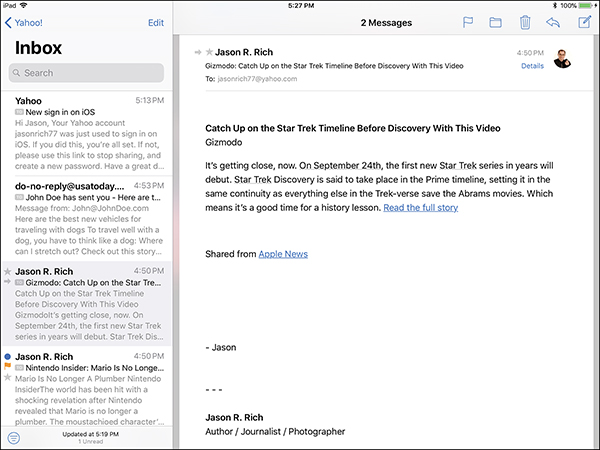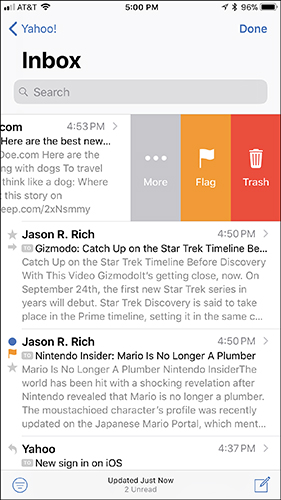11. Send And Receive Emails with the Mail App
In this Chapter
![]() Sending and receiving emails using the Mail app
Sending and receiving emails using the Mail app
![]() Managing emails from your inbox(es)
Managing emails from your inbox(es)
![]() Discovering new Mail app features and functions
Discovering new Mail app features and functions
If you’re someone who’s constantly on the go, being able to send and receive emails from virtually anywhere there’s a cellular or Wi-Fi Internet connection enables you to stay in touch, stay informed, and be productive from wherever you happen to be.
The Mail app offers a comprehensive set of tools to help you compose, send, receive, and organize emails from one or more of your existing email accounts. From your iPhone or iPad, you can simultaneously manage your personal and work-related email accounts, as well as the free email account that’s provided when you set up an iCloud account.
Before you can begin using the Mail app, it’s necessary to set up your existing email accounts from within Settings.
If you don’t yet have an email account, there are several ways to get one. You can sign up for a free Apple iCloud account, which includes an email account. In addition, Google offers free Gmail accounts (http://mail.google.com), and Yahoo! offers free Yahoo! Mail accounts (https://login.yahoo.com/account/create), both of which are fully compatible with your iOS device’s Mail app.
Adding Email Accounts to the Mail App
You use the Settings app to add accounts to work with the Mail app. The Mail app works with virtually all email accounts, including industry-standard POP3 and IMAP email services.
If you have an email account through your employer that doesn’t initially work using the setup procedure outlined in this chapter, contact your company’s IT department or Apple’s technical support for assistance.
![]() Note
Note
The process for setting up an existing email account to use with your iPhone or iPad and the Mail app needs to be done only once per account.
Follow these steps to set up your iOS device to work with each of your existing email accounts:
1. Launch Settings.
2. Tap Account & Passwords.
3. From below the Accounts heading, tap Add Account.
4. Select the type of email account you have. Your options include iCloud, Microsoft Exchange, Google (Gmail), Yahoo!, AOL, Outlook.com, or Other (see Figure 11.1). Tap the appropriate option.
![]() Note
Note
If you have a POP3 or IMAP email account that doesn’t otherwise fall into one of the provided email types, tap the Other option and follow the onscreen prompts. You need to enter information that’s provided by your Internet Service Provider or email service provider.
If you have an existing Yahoo! email account, for example, tap the Yahoo! option. When the Yahoo! account Sign In screen appears (see Figure 11.2), enter the email address that’s associated with the account, tap Next, and then enter the account’s password.
FIGURE 11.1
Choose the type of email account you’d like to add by tapping the appropriate option.

FIGURE 11.2
If you’re setting up a Yahoo! Mail account, tap the Yahoo! option, and then fill in your existing account information.
As you’re adding an email account from within Settings, depending on the account type, you might be prompted to manually enter the account name. This should be your full name (or whatever you want to appear in the From field of outgoing emails). You can opt to use just your first name, a family name (such as “The Anderson Family”), or a nickname, based on what you want to share with the recipients of your emails.
If prompted for a description, you can enter anything that helps you personally differentiate the account from your other accounts, such as Home Email, Work Email, or Yahoo! Email. The description is something that you see only on your device.
5. After you’ve entered information for your existing email account, your iOS mobile device connects to the email account’s server and confirms the account details.
6. After the account has been verified, you see a new window with options. They’re probably labeled Mail, Contacts, Calendars, Reminders, and Notes, although depending on the type of email account you’re setting up, some of these options might not be available. Be sure to turn on the virtual switch associated with the Mail option. Figure 11.3 shows how the menu looks when setting up a Yahoo! Mail account to work with an iPhone.
![]() Note
Note
The rest of the options offered by this Settings submenu are used to determine what additional app-specific data can be linked with the Mail account and related apps on your mobile device and that you use elsewhere.
![]() Caution
Caution
If you’re already syncing app-specific data for Contacts, Calendar, Reminders, or Notes with iCloud, do not also sync them with Yahoo!, Google, or a Microsoft Exchange–compatible account, or you could wind up with duplicate records or entries in each app. Likewise, if you’re already syncing your app-specific data with Google, don’t also sync this information using iCloud.
7. Tap the Accounts option. Below the Accounts heading within the Accounts & Passwords submenu, the newly added email account is listed.
8. Below the Accounts listing is the Fetch New Data option. Use this to determine how often your iOS device automatically accesses the Internet to check for and download new incoming email messages from each email account’s server.
FIGURE 11.3
For email accounts related to online services, such as Yahoo! or Google, you’ll be prompted to choose what additional content you want to sync and share with your iOS mobile device. Be sure to turn on the virtual switch associated with Mail.
![]() Tip
Tip
Tap Fetch New Data to customize how you receive new email. From the Fetch New Data submenu screen, either enable or disable the master Push feature. When turned on, your iPhone or iPad automatically accesses and displays new incoming emails as they arrive on your email account’s server.
When the Push feature is turned off, select how often you want to check for new emails using the Fetch feature. Your options include Automatically, Manually, Hourly, Every 30 Minutes, or Every 15 Minutes.
For each email account, manually select the Push or Fetch feature (some types of email account support only one or the other). From below the Fetch heading, customize the Fetch option.
The benefit of having the Fetch feature set to Manually is that you can greatly reduce your cellular data usage. This is important if you have a monthly data allocation through your cellular service provider. If you have an account that offers unlimited wireless data, or you use a Wi-Fi connection, this is not a concern. Using the Fetch (Manually) feature can also help you extend your device’s battery life.
9. If you have another existing email account to set up, return to step 3 and repeat this process. Otherwise, exit the Settings app and launch the Mail app.
![]() Tip
Tip
Depending on the type of email account you’re setting up, the information for which you’re prompted will vary.
If you plan to set up a POP3 or IMAP email account, in addition to your existing email address and password, you might be prompted to enter your host name [mail.example.com] and outgoing mail server information [smtp.example.com]. Obtain this information from your email account provider, Internet service provider, or the IT department at your company before attempting to set up this type of account on your iPhone or iPad.
After at least one email account account is set up, return to the main Settings menu and select the Mail option. From the Mail submenu, you’re able to customize a wide range of options pertaining to how the iOS mobile device you’re using accesses, displays, and organizes your emails. For example, by tapping on the Notifications option, you’re able to adjust how you’re alerted when new (incoming) emails are received to each of your email accounts.
![]() Tip
Tip
When you purchase a new iOS device, it comes with free technical support from AppleCare for 90 days. If you purchased AppleCare+ with your iOS device, you have access to free technical support from Apple for two years. This includes the ability to make an in-person appointment with an Apple Genius at any Apple Store and have someone set up your email account(s) on your iPhone or iPad for you.
To schedule a free appointment, visit www.apple.com/retail/geniusbar. Or call Apple’s toll-free technical support phone number and have someone talk you through the email setup process. Call 800-APL-CARE (275-2273).
Customizing Mail Options From Settings
To customize options available in the Mail app, launch Settings and select the Mail option. Displayed on the Mail submenu screen (see Figure 11.4) are a handful of customizable features for managing your email accounts.
FIGURE 11.4
From Settings, you can customize a handful of settings relating to the Mail app and how your incoming and outgoing emails (from all of your accounts linked with your iPhone or iPad) are handled.
At the top of the Mail submenu screen within Settings, tap Siri & Search and turn on the virtual switch associated with this feature to allow Siri and the Spotlight Search feature built into iOS 11 access Mail-related data from your email account(s).
Next, tap Notifications, turn on the Allow Notifications option displayed at the top of the submenu, and then tap each listed email account to customize Notifications-related options. These include how the selected mail account (and the Mail app) uses sounds, the Badge App Icon, and alerts to get your attention when new (incoming) emails arrive in your inbox.
Notice that the VIP mailbox is treated like a separate email account when it comes to setting Notifications. As you work with the Mail app, you’re able to create a master VIP list (comprising important people you communicate with across all your accounts). When you receive an incoming email from someone you have manually added to the VIP list, this type of Notification can be handled differently to ensure it gets your attention. How to manage your VIP list is discussed later in this chapter.
When you scroll down the Mail submenu screen, the following customizable options relating to how the Mail app manages your email accounts and email messages are offered:
![]() Preview—As you look at your Inbox (or any mailbox) using the Mail app, determine how much of each email message’s body text is visible from the mailbox summary screen, in addition to the From, Date/Time, and Subject. Choose None, or between one and five lines of the email message to preview.
Preview—As you look at your Inbox (or any mailbox) using the Mail app, determine how much of each email message’s body text is visible from the mailbox summary screen, in addition to the From, Date/Time, and Subject. Choose None, or between one and five lines of the email message to preview.
![]() Tip
Tip
The Preview option also affects the email-related notifications that appear in the Notification Center if you assign it to continuously monitor the Mail app. You can adjust this in Settings by tapping the Notifications option from the main Settings menu.
![]() Show To/Cc Label—Decide whether to view the To and Cc fields when viewing the preview screen for emails.
Show To/Cc Label—Decide whether to view the To and Cc fields when viewing the preview screen for emails.
![]() Swipe Options—This feature helps you manage the Inbox of your email accounts. As you’re looking at the previews of each message in your Inbox, swipe across each message listing to access menu options. Configure which Mail-related command(s) become available to you by swiping across a message listing (see Figure 11.5).
Swipe Options—This feature helps you manage the Inbox of your email accounts. As you’re looking at the previews of each message in your Inbox, swipe across each message listing to access menu options. Configure which Mail-related command(s) become available to you by swiping across a message listing (see Figure 11.5).
FIGURE 11.5
Access commonly used commands for managing incoming messages by swiping your finger across a message listing.
![]() Tip
Tip
Tap Swipe Options in the Mail submenu to access the Swipe Options submenu and determine which email management–related commands become available to you when you swipe across a message listing when viewing an Inbox. This only needs to be done once.
Choose the email-related commands you most often use to organize your incoming messages so you can access them faster. Figure 11.6 shows the Swipe Right submenu, which allows you to select which Mail-related commands become accessible when you swipe from left to right across a message listing within your inbox. Be sure to customize the Swipe Left and Swipe Right options separately.
FIGURE 11.6
The Swipe Right submenu allows you to customize which Mail-related commands become available when you swipe from left to right across a message listing within your inbox.
![]() Flag Style—When you flag an email as important, the Flag style determines whether the Mail app displays a flag-shaped icon or a colored dot next to each flagged email message.
Flag Style—When you flag an email as important, the Flag style determines whether the Mail app displays a flag-shaped icon or a colored dot next to each flagged email message.
![]() Ask Before Deleting—This option serves as a safety net to ensure that you don’t accidentally delete an important email message from your iOS device. When this feature is turned on, you’re asked to confirm your message deletion request before an email message is actually deleted. By default, with some email service providers, you cannot delete email messages stored on your email account’s server. When you delete a message from the Mail app, it is deleted from your iPhone or iPad but is still accessible from other devices. Check with your mail service provider to see how this feature is set up and whether it is changeable.
Ask Before Deleting—This option serves as a safety net to ensure that you don’t accidentally delete an important email message from your iOS device. When this feature is turned on, you’re asked to confirm your message deletion request before an email message is actually deleted. By default, with some email service providers, you cannot delete email messages stored on your email account’s server. When you delete a message from the Mail app, it is deleted from your iPhone or iPad but is still accessible from other devices. Check with your mail service provider to see how this feature is set up and whether it is changeable.
![]() Load Remote Images—When an email message has a photo or graphic embedded in it, this option determines whether the image is automatically downloaded and displayed with the email message. You can opt to refrain from automatically loading graphics with email messages to reduce the amount of data transferred to your iPhone or iPad (which is a consideration if you’re connected to the Internet via a cellular data network). You still have the option to tap the placeholder icon in the email message to manually download the images in a specific message.
Load Remote Images—When an email message has a photo or graphic embedded in it, this option determines whether the image is automatically downloaded and displayed with the email message. You can opt to refrain from automatically loading graphics with email messages to reduce the amount of data transferred to your iPhone or iPad (which is a consideration if you’re connected to the Internet via a cellular data network). You still have the option to tap the placeholder icon in the email message to manually download the images in a specific message.
![]() Note
Note
In addition to reducing your cellular data usage, disabling the Load Remote Images option can help cut down on the amount of spam (unsolicited emails) you receive. Remote image loading can be tracked by the senders of spam and used to verify valid email addresses. When the senders are able to verify your address, they can send you more mail. If you don’t load the image, your address is unverified to the sender.
When turned off, displaying images embedded within an email requires an additional step on your part because you now must tap the image icon to load the image if you want to view it.
![]() Organize by Thread—This feature enables you to review messages in reverse chronological order if a single message turns into a back-and-forth email conversation in which multiple parties keep hitting Reply to respond to messages with the same subject. When turned on, this makes keeping track of email conversations (called threads) much easier, especially if you’re managing several email accounts on your iPhone or iPad. If it’s turned off, messages in your Inbox are displayed in reverse chronological order as they’re received, not grouped by subject or sender.
Organize by Thread—This feature enables you to review messages in reverse chronological order if a single message turns into a back-and-forth email conversation in which multiple parties keep hitting Reply to respond to messages with the same subject. When turned on, this makes keeping track of email conversations (called threads) much easier, especially if you’re managing several email accounts on your iPhone or iPad. If it’s turned off, messages in your Inbox are displayed in reverse chronological order as they’re received, not grouped by subject or sender.
![]() Collapse by Thread—As you read email messages as part of a long thread (back and forth email conversation), the Mail app automatically collapses read messages making it easier to scroll through a conversation. Simply tap any message to expand and reread it, as needed.
Collapse by Thread—As you read email messages as part of a long thread (back and forth email conversation), the Mail app automatically collapses read messages making it easier to scroll through a conversation. Simply tap any message to expand and reread it, as needed.
![]() Tip
Tip
Also available from the Mail submenu within Settings are the Most Recent Message on Top and Complete Threads options, which are displayed below the Threading heading. Turn on the Most Recent Messages on Top option to display the newest (most recent messages) first when viewing the conversation thread. Turn on the Complete Threads option if you want all messages within the thread to be displayed, even when some messages have been moved to other mailboxes.
When viewing an Inbox, tap the >> icon that’s displayed to the right of the time and date a message was received to expand the thread and see listings for all messages within that thread, without first actually opening the latest message. To close the expanded thread in the inbox, tap the icon that contains two downward-pointing arrows.
![]() Always Bcc Myself—When this feature is turned on, a copy of every outgoing email is sent to your Inbox. Typically, all outgoing messages are automatically saved in a Sent folder related to that account. If your email account type does not enable you to access sent emails from another computer or device, using the Bcc Myself option compensates for this. When you send an email message from your iPhone or iPad, using this feature ensures that the message becomes accessible from your primary computer.
Always Bcc Myself—When this feature is turned on, a copy of every outgoing email is sent to your Inbox. Typically, all outgoing messages are automatically saved in a Sent folder related to that account. If your email account type does not enable you to access sent emails from another computer or device, using the Bcc Myself option compensates for this. When you send an email message from your iPhone or iPad, using this feature ensures that the message becomes accessible from your primary computer.
![]() Mark Addresses—With this option, you can enter a portion of an email address and then be alerted each time an email is received that meets that search criteria. For example, if you do business with many people who work at The Widget Company and their email addresses end with @widget.com, anyone with an email address ending with @widget.com, such as [email protected], [email protected], or [email protected], can be automatically flagged in your Inbox to get your attention. All you have to do is store “widget.com” in the Mark Address field. This feature is particularly useful if you work in a corporate environment.
Mark Addresses—With this option, you can enter a portion of an email address and then be alerted each time an email is received that meets that search criteria. For example, if you do business with many people who work at The Widget Company and their email addresses end with @widget.com, anyone with an email address ending with @widget.com, such as [email protected], [email protected], or [email protected], can be automatically flagged in your Inbox to get your attention. All you have to do is store “widget.com” in the Mark Address field. This feature is particularly useful if you work in a corporate environment.
![]() Increase Quote Level—When turned on, anytime you reply to a message or forward a message, the content of that original email appears indented, making it easier to differentiate between the message you add and the original message being replied to or forwarded. This option affects the message formatting, not the actual content.
Increase Quote Level—When turned on, anytime you reply to a message or forward a message, the content of that original email appears indented, making it easier to differentiate between the message you add and the original message being replied to or forwarded. This option affects the message formatting, not the actual content.
![]() Signature—For every outgoing email that you compose, you can automatically add an email signature. The default signature is “Sent from my iPhone” or “Sent from my iPad.” However, with this option you can create customized signatures for each email account. A signature might include your name, mailing address, email address, phone numbers, and so forth.
Signature—For every outgoing email that you compose, you can automatically add an email signature. The default signature is “Sent from my iPhone” or “Sent from my iPad.” However, with this option you can create customized signatures for each email account. A signature might include your name, mailing address, email address, phone numbers, and so forth.
![]() Note
Note
From the Signature submenu screen within Settings, you can create a signature and use it with all email accounts by selecting the All Accounts option. However, you can assign different signatures to each of your accounts by selecting the Per Account option.
![]() Default Account—If you’re using the Mail app to manage multiple email accounts, when you reply to a message or forward a message, it is always sent from the email account to which the message was originally sent. However, if you tap the Compose New Email icon to create a new email from scratch, the email account from which the message is sent is whichever you have set up as the Mail app’s default account. If you want to change this account for a specific email, simply tap the From field as you’re composing a new email and select one of your other accounts.
Default Account—If you’re using the Mail app to manage multiple email accounts, when you reply to a message or forward a message, it is always sent from the email account to which the message was originally sent. However, if you tap the Compose New Email icon to create a new email from scratch, the email account from which the message is sent is whichever you have set up as the Mail app’s default account. If you want to change this account for a specific email, simply tap the From field as you’re composing a new email and select one of your other accounts.
Viewing Your Incoming Mail
When you launch the Mail app, the Inbox for your various email accounts is displayed. You can opt to display incoming messages for a single email account, or display the incoming messages from all of your email accounts by selecting the All Inboxes option.
Even though Mail enables you to simultaneously view incoming emails from multiple accounts within a single listing (on the same screen), behind the scenes, the app automatically keeps your incoming and outgoing emails and your various email accounts separate. So if you opt to read and respond to an email from your work-related Inbox, for example, that response is automatically sent out from your work-related email account and saved in the Sent folder for that account.
Viewing all the Inboxes for all of your accounts simultaneously makes it faster to review your incoming emails, without having to manually switch between email accounts.
If you have multiple email accounts being managed from your iOS device, to view all of your Inboxes simultaneously, or to switch between Inboxes, follow these steps:
1. Launch the Mail app.
2. The Inbox you last looked at is probably displayed. If only one email account is set up to work with your iPhone or iPad, the last email you viewed is displayed.
3. Tap Mailboxes in the upper-left corner of the screen to see a list of your inboxes so you can select which Inbox you want to view. If you’re looking at a particular account’s Inbox, the arrow-shaped option is labeled with the name of the mailbox.
4. From the menu that appears, the first option displayed is All Inboxes. Tap it to view a single listing of all incoming emails, or tap any single email account that’s listed on the Mailboxes screen.
![]() Tip
Tip
If you receive an email from an automated email list that you’re on, and the Mail app determines this, at the very top of the message is a banner that states, “This message is from a mailing list.” You’re then given the option to unsubscribe to that list with a single tap of the screen (see Figure 11.7). This feature, when used over time, can help you reduce the amount of spam or unwanted (and unsolicited) email you receive.
FIGURE 11.7
Tap the Unsubscribe option above the email’s header if you want to immediately request to be removed from the mass email list.
![]() Tip
Tip
Tap the VIP mailbox listing to view only emails from your various Inboxes that have been received from people you’ve added to your VIP list. When you tap the VIP option, the emails are displayed in a single list of all the VIP messages from all the accounts you’re managing on your iPhone or iPad.
Below the VIP listing under the Inboxes heading is a Flagged listing. This enables you to view a separate mailbox comprising only emails (and message threads) you’ve previously flagged as being important. Again, this is a comprehensive list from all the accounts you’re managing on your iPhone or iPad. The Mail app keeps the messages sorted behind the scenes, based on which account each is associated with.
![]() Tip
Tip
As you’re viewing any Inbox (or All Inboxes) the Filtered by Unread icon is in the bottom-left corner of the screen. Tap it to see only new, unread messages. Tap the icon again to turn off this feature and view all messages currently stored in the selected Inbox(es).
As you’re viewing a listing of messages within All Inboxes, a specific inbox, or any mailbox, type a keyword, date, name, email address, or search phrase in the Search field to quickly find a particular message or message thread that contains the search word or phrase you entered.
![]() Tip
Tip
A >> icon displayed to the immediate right of the time and date an email message was received in your Inbox indicates that the message is part of an ongoing message thread. Tap the >> icon to display all messages in that thread within the Inbox. Tap the icon again to condense the message thread to a single message listing. Tap the message listing to open and view the entire message (as well as all previous messages in the thread).
Composing an Email Message
From the Mail app, it’s easy to compose an email from scratch and send it to one or more recipients. Just tap the Compose icon. On an iPhone, the Compose icon is in the lower-right corner of the screen in the Mail app. On an iPad, the Compose icon is in the top-right corner of the screen.
![]() Note
Note
The Compose icon looks like a square with a pencil on it.
When you tap the Compose icon, a blank New Message email message template appears. Using the virtual keyboard, fill in the To, Cc, Bcc, and Subject fields (see Figure 11.8). You must fill in the To field with a valid email address for at least one recipient. The other fields are optional.
You can send the same email to multiple recipients by either adding multiple email addresses to the To field or adding email addresses to the Cc or Bcc fields.
The From field is automatically filled in with your email address. If you’re managing multiple email addresses from the iPhone or iPad, the default address (which you select from the Mail submenu within Settings) is used. If you want to change the address from which the email is being sent, tap the From field to select one of your other accounts. See the “Customizing Mail Options from Settings” section earlier in this chapter for information on changing the default account.
FIGURE 11.8
Tap the Compose icon to create an email from scratch and send it from your iOS device.
![]() Tip
Tip
As you fill in the To field when composing an email, the Mail app automatically accesses your Contacts database to match up entries. This feature can save you time, because you don’t have to manually enter that entire email address. If you know that the person you’re sending an email to is already in your Contacts database, you can type that person’s name in the To field.
The Mail app also remembers email addresses for people with whom you’ve corresponded in the past through email via the Mail app, even if those addresses are not stored in your Contacts database. If you begin entering an email address that the Mail app recognizes, the app gives you the option to auto-complete the address and fill in the To field.
When you begin manually entering an email address, the Mail app offers suggestions. Either select a suggestion or continue typing.
Next, tap the Subject field and use the virtual keyboard to enter the subject for your message. As you do this, the subject appears at the very top center of the Compose window (replacing the New Message heading).
When using almost any app with a Share menu, to compose and send an email that contains app-specific content without first launching the Mail app, tap the Share icon and select Mail from the Share menu.
A New Message screen appears with the related app-specific content already attached to that outgoing email message. Use the virtual keyboard to compose your email, and then tap the Send icon. The email message is sent and you are returned to the app you were using.
To begin creating the main body of the outgoing email message, tap in the main body area of the Compose Message screen, and begin using the virtual keyboard (or an optional external keyboard) to compose your message. You also have the option of tapping the Dictation key and then dictating your message using the Dictation feature.
![]() Caution
Caution
If you have the Auto-Capitalization, Auto-Correction, or Check Spelling features turned on, as you type, the iPhone or iPad automatically corrects anything that it perceives as a typo or misspelled word. Be very careful when using these features because they are notorious for plugging the wrong word into a sentence. Especially if you’re creating important business documents and emails, make sure you carefully proofread whatever you type before sending it. Typically, these features are helpful, but they do have quirks that can lead to embarrassing and unprofessional mistakes.
To control the Auto-Capitalization, Auto-Correction, and Check Spelling features, launch Settings, tap the General option, select the Keyboard option, and then turn on or off the virtual switch associated for each option displayed in the Keyboard menu screen.
![]() Tip
Tip
When turned on, the QuickType feature monitors what you’re typing in real time and anticipates what you’re about to type (based on the context of what you’re typing). It then suggests appropriate words or phrases.
Use this feature to speed up and improve the accuracy of your typing. The QuickType suggestions are displayed as tabs just above the virtual keyboard (see Figure 11.9). In this case, the word “hope” was being typed. After the user typed the letters “h” and “o,” however, the iPhone predicted that the word “hope” would be used, and offered it as a recommendation within a tab displayed above the virtual keyboard.
Tap a suggestion tab to select that word and insert it into your message. Then continue typing.
FIGURE 11.9
The QuickType feature works nicely when composing emails using the Mail app. Notice the suggested text displayed in tabs just above the virtual keyboard.
![]() What’s New
What’s New
With iOS 11 running on any iPad, you might notice that as you’re using the virtual keyboard, two numbers, letters, and symbols appear on each key (see Figure 11.10). The number, letter, or symbol displayed in black is the main option. For example, if you want to type the letter b, tap the B key, which also displays a slash (/) in gray. To type a slash, place your finger on the B key and swipe down, and then tap the / symbol.
To switch to uppercase letters, tap the Shift key (the upward-pointing arrow key at the far left of the keyboard). To turn on Shift Lock so everything you type is in uppercase, double-tap the Shift key.
To alter the virtual QuickType keyboard to display symbols and numbers, tap the .?123 key. To return to the alphanumeric keyboard, tap the ABC key.
FIGURE 11.10
To access the “alternate” letter, number, or symbol that’s displayed on an iPad’s virtual keyboard key, press and hold the key. When the alternate letter, number, or symbol is displayed prominently, tap it.
The signature you set up from within Settings for the selected From account is automatically displayed at the bottom of each newly composed message. You can return to Settings to turn off the Signature feature or change the signature that appears. A signature can also be edited or added manually, directly from the Compose screen, as you create or edit each message.
When your email is fully written and ready to be sent, tap the Send option. In a few seconds, the message is sent from your iOS device, assuming that it is connected to the Internet. A copy of the message appears in your Sent or Outbox folder. As a message is being sent, a “Sending” notification appears near the bottom of the Mail app’s screen.
![]() Tip
Tip
The Mail app enables you to format your outgoing email messages and include bold, italic, and underlined text (as well as combinations, like bold-italic text).
On an iPhone, you format text within an email message you’re composing by typing the text as you normally would using the virtual keyboard. After the text appears in your email, hold your finger on a word to make the Select, Select All, Paste, Quote Level, Insert Photo or Video, and Add Attachment command tabs appear above that word.
Tap Select, and then use your finger to move the blue dots to highlight the text you want to modify. When the appropriate text is highlighted in blue, tap the right-pointing arrow above the text (next to the Cut, Copy, and Paste commands), and then tap the BIU option. A new menu appears above the highlighted text with three options labeled Bold, Italic, and Underline (shown in Figure 11.11). Tap one or more of these tabs to alter the highlighted text.

FIGURE 11.11
On an iPhone, you can format text after it’s been typed in the Mail app. You can add bold, italic, or underline.
On an iPad, in the top-right corner of the virtual keyboard is a text formatting (BIU) icon, as well as an Attach Photo and a File Attachment icon (refer to Figure 11.12). By tapping this formatting icon and selecting a typestyle, you can format text in real time as you’re typing. If you want to type using bold/italic text, for example, tap the B and I icons. Alternatively, you can use the Select command after text is typed, and adjust the typestyle using the directions outlined earlier for the iPhone.
FIGURE 11.12
Format text as you’re composing an email on an iPad (using the virtual keyboard) by tapping on the BIU option.
![]() What’s New
What’s New
If you’re using an iPad Pro with a Smart Keyboard, you can use a handful of keyboard shortcuts to quickly format text. Refer to Chapter 3, “Take Advantage of iOS 11 Features for the iPad,” to learn more about the Smart Keyboard and keyboard shortcuts.
![]() Tip
Tip
When using any iPad model, to more accurately move the cursor around the screen (to select content to cut and paste, for example) place two fingers together on the screen (directly over the cursor), and then drag your fingers around on the screen. Also, if you’re using an external keyboard with your iPad, press the Control, Command, or Options key to access available shortcuts (which are specific to the app and keyboard you’re currently using).
Inserting a Photo or Video into Outgoing Mail
As you’re composing an outgoing email on an iPhone, one way you can insert a photo or video clip that’s stored in the Photos app into that email is to place and hold your finger anywhere in the body of the email where you want to embed the content.
![]() Note
Note
On the iPhone, tap the right-pointing arrow displayed to the right of the Select, Select All, and Paste commands to access the Insert Photo or Video option.
When the Insert Photo or Video tab is displayed, tap it. Select the photo you want to insert into the email by selecting an album and then tapping an image or video thumbnail. The photo/video you selected is previewed in the Choose Photo window. Tap the Use button to insert the photo or video into your email.
![]() What’s New
What’s New
On the iPad, tap the Attach Photo icon to select and import a photo (from the Photos app) into your email, or tap the File Attachment icon to attach to your outgoing email a file, document, or photo that’s stored within one of your cloud-based accounts (such as iCloud Drive or Dropbox) that are linked with the new File app. Refer to Chapter 7, “Use iCloud and the Files App,” for more information about using your iPhone or iPad with a cloud-based file-sharing and file-storage service.
If you’re using an iPad Pro, launch the Photos app side-by-side with the Mail app, and then use iOS 11’s Multitasking feature to drag-and-drop selected photos directly into the body of the email you’re composing.
Repeat this process to include multiple images within an email, keeping in mind that the overall file size associated with the outgoing email is often limited by your email service.
![]() Tip
Tip
When you insert a photo into an outgoing email you are prompted to choose the image size. Your options include Small, Medium, Large, and Actual Size. Each is accompanied by the file size of the image(s) you’re sending. Tap one of these options when prompted.
On the iPad, tap the Images option to the right of the Cc/Bcc, From field, and then tap the Small, Medium, Large, or Actual Size tab on the newly displayed Image Size field to customize the image file size.
Inserting an Email Attachment
To add a file attachment into an email you’re composing, place and hold down your finger in the body of the email where you want to insert the file. From the menu that appears tap the Add Attachment option. Alternatively, if you’re using an iPad, simply tap the File Attachment icon at the extreme right on the toolbar above the virtual keyboard.
![]() What’s New
What’s New
If you’re using an iPad Pro, to attach a file to an outgoing email from the Mail app, use Multitasking mode to launch the Files app while you’re composing an email. Locate and select the files you want to attach to or embed within the outgoing email, and then drag and drop one or more files from the Files app directly into the Mail app when the two apps are displayed side by side.
When you opt to attach a file to an outgoing email, your iOS mobile device accesses online accounts linked with the Files app, and enables you to select one or more files stored within one of your compatible cloud-based accounts, such as iCloud Drive or Dropbox. (Most files stored locally within your iPhone or iPad, with the exception of photos, are not accessible for sharing from the Mail app.)
Select the file of files you want to attach to the outgoing email by tapping its icon or listing and then tap Done. The selected files are attached to the outgoing email message.
Using Select, Select All, Cut, Copy, and Paste
The iOS operating system offers Select, Select All, Cut, Copy, and Paste commands, which are accessible from many iPhone or iPad apps, including Mail. Using these commands, you can quickly copy and paste content from one portion of an app to another or from one app into another app, whether it’s a paragraph of text, a phone number, or a photo.
![]() Note
Note
If you’re an iPad Pro user, you’re also able to use Multitasking mode to drag and drop content between apps.
To use these commands, use your finger to hold down on any word or graphic element on the screen for one or two seconds, until the Select and Select All tabs appear above that content. To select a single word or select the content you want to copy or cut, tap the Select tab. Alternatively, to select all the content on the screen, tap the Select All tab.
After text (or a graphic element, such as a photo) is selected, tap the Cut tab to delete the selected content from the screen (if this option is available in the app you’re using), or tap the Copy tab to save the highlighted content in your iPhone or iPad’s virtual clipboard.
Now, move to where you want to paste the saved content. This can be in the same email or document, for example, or in another app altogether. Choose the location on the screen where you want to paste the content, and hold your finger on that location for two or three seconds. When the Paste tab appears, tap it. The content you just copied to the virtual clipboard is pasted into that location.
![]() Tip
Tip
On the iPad, the Undo, Redo, and Clipboard icons are displayed above the virtual keyboard. If you’re using a Smart Keyboard, these commands can be accessed via keyboard shortcuts.
Tap the Undo icon to go one step back and undo the last thing you did when composing the email. Tap the Redo icon to counteract what the Undo command just did.
When you select content in an outgoing email, for example, the Cut, Copy, and Paste command icons are displayed on the top-left side of the virtual keyboard. Tap the scissor-shaped icon to use the Cut command. The icon that looks like two sheets of paper represents the Copy command, and the clipboard-shaped icon works as the Paste command.
![]() Tip
Tip
In the Mail app, as you use the Select, Select All, Cut, Copy, and Paste commands, notice a Quote Level option that appears on the menu above the highlighted text or content you select. Tap this to increase or decrease the indent of that content, which impacts how it’s formatted on the screen.
Saving an Unsent Draft of an Email
To save a draft of an email without sending it, as you’re composing the email message, tap the Cancel button in the upper-left corner of the Compose message window. Two command buttons appear: Delete Draft and Save Draft. To save the unsent draft, tap Save Draft.
You can return to it later to modify and send it. To do this, from the main Inbox screen in Mail, tap the left-pointing Mailboxes at the upper-left corner of the screen. From the Mailboxes screen, scroll down to the Accounts heading, and tap the listing for the email account from which the email draft was composed.
When you see a list of folders related to that email account, tap the Drafts folder. Tap the appropriate listing to open the email message. You can now edit the message or send it.
Reading Email
Just like the Inbox on your main computer’s email software, the Inbox of the Mail app (shown in Figure 11.13 on an iPhone) displays your incoming emails.
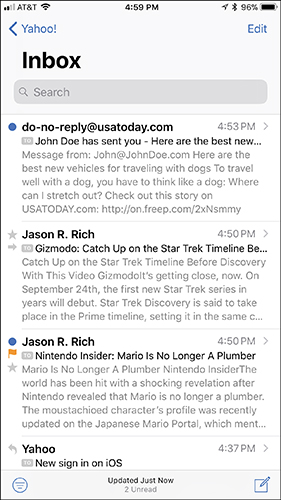
FIGURE 11.13
The Inbox screen of the Mail app displays a list of your incoming emails on the iPhone.
On an iPhone, the Inbox screen takes up the entire screen. On an iPad, the Inbox list is displayed on the left side of the screen, while a selected email message is displayed on the right side of the screen (see Figure 11.14).
FIGURE 11.14
The Inbox screen of the Mail app on an iPad is displayed on the left, while the entire selected email message (highlighted in gray in the Inbox list) is displayed on the right.
![]() Note
Note
As you’re looking at the Inbox for any of your email accounts (or the All Inboxes mailbox), to the left of each email message preview you might see an icon. A blue dot represents a new and unread email (or an email that has been marked as unread). A solid blue star represents a new and unread email from someone on your VIP list, and a gray star icon represents a read email from someone on your VIP list.
An orange flag-shaped icon to the left of an email preview means that you have manually flagged that message (or message thread) as urgent. Instead of a flag icon, a blue dot with an orange circle can be displayed indicating a message is urgent and unread. Just an orange dot is displayed after the message has been read. You can choose between a flag or a dot icon from Settings.
A curved, left-pointing arrow icon means that you have read and replied to that message, whereas a right-pointing arrow icon means you’ve read and have forwarded that message to one or more people.
A bell icon means that the Notify Me option has been turned for that message.
If no tiny icon appears to the left of an email preview listing, the message has been read and is simply stored in that inbox (or mailbox).
When you’re viewing your Inbox(es), a list of the individual emails is displayed. Based on the customizations you make from the Settings app from the Mail submenu, the Sender, Subject, Date/Time, and up to five lines of the message’s body text can be displayed for each incoming message listing.
![]() Note
Note
If you’re using the Mail app on an iPad while holding the tablet in portrait mode, place your finger near the left side of the screen and swipe to the right to open the Inbox sidebar.
On the iPhone, when viewing your Inbox and the listing of incoming (new) email messages, tap any message listing to read that message in its entirety. When you do this, a new message screen appears. At the bottom of this screen is a series of command icons for managing that email.
![]() Tip
Tip
When you receive an email from someone whose contact information in your Contacts app has changed, you see a banner at the top of the message that states, “New Contact Info Found.” Tap Add to automatically update that person’s Contact entry with the new or updated information.
![]() Tip
Tip
If you’re using a newer iPhone model, take advantage of the 3D Touch features to quickly review emails. As you’re looking at the Inbox listing, place and hold your finger gently on a specific email listing. A preview of that entire email message is displayed. If you want to open and read the message, press down on the screen a bit harder when the preview is visible.
On the iPad, the email message that’s highlighted in gray on the left side of the screen is the one that’s currently being displayed, in its entirety, on the right side of the screen. Tap any email on the left side of the screen to view the entire message on the right side of the screen.
Located at the top of the Inbox message listing is a Search field. You might need to swipe your finger downward along the Inbox to reveal it. Tap the Search field to make the virtual keyboard appear so you can enter a search phrase and quickly find a particular email message. You can search the content of the Mail app using any keyword, a sender’s name, a date, or an email subject, for example. You can also use your device’s Spotlight Search feature to quickly locate content within email messages.
When using an iPad Pro with the 12.9-inch screen, the Mail app uses a three-pane view (as opposed to just two). On the extreme left is the Mailboxes pane. The middle pane is the selected Inbox message listing, and the right pane displays the selected message.
Managing the Inbox with the Edit Button
Located on top of a mailbox’s message listing (to the right of its heading) is the Edit button. Tap this option to quickly select multiple messages from a mailbox, such as your Inbox, and delete or move the selected content to another mailbox (or folder), as shown in Figure 11.15.
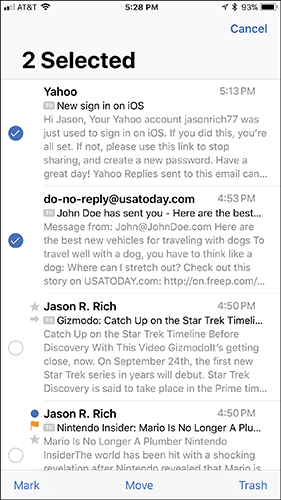
FIGURE 11.15
Tap the Edit button, and then manage your incoming messages, mark them, delete them in quantity, or move them to the Trash folder.
After tapping Edit, manually select one or more message listings to move or delete, or tap the Mark All option to select all the messages in that Inbox. You can use the Flag or Mark As Read/Unread options for all the selected messages.
![]() Tip
Tip
If you tap the Mark button to the left of the Trash and Move buttons, you can then flag them or mark one or more emails as read or unread. You can also move selected messages to your Junk folder.
After you tap the Edit button, an empty circle icon appears to the left of each email message preview listing. To move or delete one or more messages from the current mailbox’s listing (which could be your Inbox, VIP, Archive, or Junk mailbox), tap the empty circle icon for that message. A blue-and-white check mark fills the empty circle when you do this, and the Mark, Move, and Trash options are displayed at the bottom of the screen.
After you’ve selected one or more messages, tap the Trash button to delete one or more messages simultaneously from the mailbox (they go to the Trash folder), or tap the Move button and then select to which folder you want to move those email messages. Tap the Mark option to Flag the message, mark it as unread, or move it to the Junk folder.
To exit this option without doing anything, tap the Cancel button displayed at the top of the Inbox listing.
Deleting Individual Incoming Messages
As you’re looking at the listing of messages in your Inbox (or any mailbox), you can delete individual messages, one at a time, by swiping your finger from right to left over a message listing. Tap the red-and-white Trash option to delete the message.
Tap the More (…) option to access a menu (shown in Figure 11.16) to access a more detailed menu that includes options for Reply, Reply All, Forward, Mark, Show Related Messages, Notify Me, and Move Message options (see Figure 11.17).
FIGURE 11.16
After swiping from right to left across a message listing in your Inbox, tap More to reveal this menu.
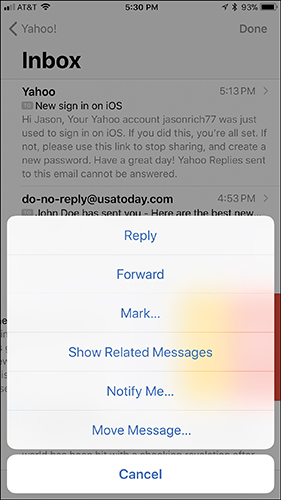
FIGURE 11.17
The More menu provides another way to access commonly used features for managing your email messages.
Another way to delete a message from your Inbox, or any mailbox, is to tap a message listing to view that message, and then tap the Trash icon.
Viewing Your Emails
When a single email message is selected from the Inbox listing, that message is displayed in its entirety. At the top of the message, see the From, To, Cc/Bcc (if applicable), Subject, and the Date/Time it was sent.
In the upper-right corner of the email message is a blue Hide command. If you tap this, some of the message header information will no longer be displayed. To make this information reappear, tap the More (…) option.
As you’re reading an email, tap the flag icon to flag that message and mark it as urgent, or mark the email as unread. These options appear within a pop-up menu. When you flag a message, an orange flag (or an orange dot) is displayed in the message itself (to the right of the date and time) and in the Inbox (mailbox) in which the message is stored. Plus, from your Inboxes menu, if you tap the Flagged option, you can view a separate mailbox that contains only flagged (urgent) messages.
Using the Mail App’s Vip List Feature
In addition to flagging individual messages as important, the Mail app can automatically highlight all emails sent from particular (important) senders, such as your boss, specific clients, close friends, or family members. Once you add a sender to your VIP List, all their incoming emails are marked with a star icon instead of a blue dot that represents a regular, new incoming email.
To add someone to your VIP list, as you’re reading an email from that person, tap the From field (the name/email address). A Sender screen (iPhone) or window (iPad) appears. Tap the Add to VIP option. This adds and keeps that sender on your custom VIP list until you manually remove them. To later remove someone from your VIP list, read any of their email messages and tap the From field. When the Sender window appears, tap the Remove from VIP option (which has replaced the Add to VIP option).
![]() Tip
Tip
From the Mailboxes menu, tap the VIP listing to view a special mailbox that displays only incoming emails from people on your VIP list. Using the VIP list feature helps you quickly differentiate important emails from spam and less important incoming emails that don’t necessarily require your immediate attention.
Dealing with Incoming Attachments
The Mail app enables you to access certain types of attachment files that accompany an incoming email message. Dozens of file formats are compatible with the Mail app. As you add third-party apps that support other file formats, they become recognized by the Mail app. This includes files related to text, photos, audio clips, video clips, PDFs, and eBooks, as well as iWork and Microsoft Office documents and files.
To open an attached file using another app, in the incoming email message, tap and hold down the attachment icon for a second. When you release your finger, you see a pop-up menu of command icons. These icons represent options for sharing, managing, printing, annotating, copying, or transferring the file to a cloud-based account your iPhone or iPad is linked with.
For example, if you receive a PDF, you can open, view, and annotate it using the Preview feature, or you can import the file into a compatible app that allows you to view or fully manage and work with PDFs, such as iBooks or the PDF Expert app (which is available from the App Store).
![]() What’s New
What’s New
If you simply tap the file attachment, in most cases, the new Preview screen displays the content of the attached file. It might take up to one or two minutes to first download the file.
Depending on the file type, you can markup and annotate the file by tapping the Markup/Annotate icon, or tap the Share icon to access the Share menu, which displays a handful of options for managing and storing files printing them (if applicable), and sharing them.
Organizing Email Messages in Folders
You can easily move email messages into a folder, enabling you to better organize your emails. Here’s how to do this:
1. From the Inbox listing, tap Edit above the Inbox listing. Or, if you’re viewing an email message, swipe your finger from right to left across the message listing.
2. Tap Move. A menu that offers various folders and options available for that email account is displayed.
3. Tap Move Message, and then tap the mailbox folder to which you want to move the message. The email message is moved to the folder you select.
The Move option is also available by swiping from right to left across a message listing from your inbox and then tapping More.
![]() Tip
Tip
As you’re managing incoming and outgoing emails, the Mail app uses the default mailboxes that are already associated with that email account, such as Inbox, Drafts, Sent, Trash, and Junk. For some accounts, you are limited to only these default mailboxes. However, for many types of email accounts, you can create additional mailboxes and then move messages into those mailboxes to organize them.
Forwarding, Printing, and Replying to Messages
As you’re reading incoming emails, you can forward a message to someone else, reply to the message, or print the email by tapping the left-pointing, curved-arrow icon displayed when you’re viewing an email. When you tap this icon, as you’re reading any email message a menu offers the following options: Reply, Forward, and Print. If the message you’re viewing has more than one recipient, an additional option, Reply All, appears.
To reply to the message you’re reading, tap the Reply (or Reply All) option. An email message template appears on the screen that already contains the content of the message you’re replying to. Refer to the “Composing an Email Message” section for details on how to write and send an email message from the Mail app.
To forward the email (or message thread) you’re reading to another recipient, tap the Forward icon. If an attachment is associated with the email, you’re asked, “Include attachments from original email?” and offered two options: Include and Don’t Include. Tap the appropriate response.
When you opt to forward an email, a new message template appears on the screen. However, the content of the message you’re forwarding appears in the body of the email message. Start the message-forwarding process by filling in the To field. You can also modify the Subject field (or leave the message’s original subject), and then add to the body of the email message with your own text. This text appears above the forwarded message’s content.
![]() Tip
Tip
To forward an email to multiple recipients, enter each person’s email address in the To field of the outgoing message, separating each address with a comma (,). Alternatively, you can tap the + to the right of the To field to add more recipients.
When you’re ready to forward the message, tap Send, or tap Cancel to abort the message-forwarding process.
If you have an AirPrint-compatible printer set up to work with your iOS device, tap the Print option that appears when you tap the left-pointing curved-arrow icon as you’re reading an email.
![]() More Info
More Info
Use these quick tips to manage your email:
![]() When viewing your Inbox, to refresh it and load new messages, swipe your finger down in Inbox. The message Updated Just Now displays at the bottom center of the Inbox screen or pane when your messages are up to date. Otherwise, the time and date that the Inbox was last updated is displayed. Your Inbox can refresh only when the iPhone or iPad has Internet access.
When viewing your Inbox, to refresh it and load new messages, swipe your finger down in Inbox. The message Updated Just Now displays at the bottom center of the Inbox screen or pane when your messages are up to date. Otherwise, the time and date that the Inbox was last updated is displayed. Your Inbox can refresh only when the iPhone or iPad has Internet access.
![]() As you’re reading email, if the text is difficult to see, you can automatically increase the size of all text displayed in the Mail, Contacts, Calendar, Messages, and Notes apps by adjusting the Accessibility option in Settings. To make this font size adjustment, launch Settings. Select the General option, and then tap the Accessibility option. From the Accessibility submenu, tap the Larger Text option. Turn on the virtual switch associated with this feature, and then use the slider to select a more suitable text size.
As you’re reading email, if the text is difficult to see, you can automatically increase the size of all text displayed in the Mail, Contacts, Calendar, Messages, and Notes apps by adjusting the Accessibility option in Settings. To make this font size adjustment, launch Settings. Select the General option, and then tap the Accessibility option. From the Accessibility submenu, tap the Larger Text option. Turn on the virtual switch associated with this feature, and then use the slider to select a more suitable text size.
![]() While looking at the Home screen on a newer iPhone model, press and hold down on the Mail app icon to make the app’s 3D Touch Pop menu appear. Four options appear, including All Inboxes (view the Inbox for all of your accounts on a single screen), VIP (view the VIP inbox), Search (enter a keyword or search phrase to find in any of your incoming or outgoing emails), and New Message (used to compose a new message from scratch).
While looking at the Home screen on a newer iPhone model, press and hold down on the Mail app icon to make the app’s 3D Touch Pop menu appear. Four options appear, including All Inboxes (view the Inbox for all of your accounts on a single screen), VIP (view the VIP inbox), Search (enter a keyword or search phrase to find in any of your incoming or outgoing emails), and New Message (used to compose a new message from scratch).
![]() When using almost any app (Contacts, Calendar, Notes, Safari, Reminders, Messages, and so on), tap an email address in the app to compose and send an email to that person via the Mail app. The To field automatically includes the email address you tapped.
When using almost any app (Contacts, Calendar, Notes, Safari, Reminders, Messages, and so on), tap an email address in the app to compose and send an email to that person via the Mail app. The To field automatically includes the email address you tapped.
![]() When you see a new message notification displayed in the Notification Center screen, on an iPad, swipe across the listing from right to left, and then tap the View option to quickly open the Mail app and view that message. On an iPhone with Touch 3D, press and hold your finger on the message listing to see a preview of that message (along with a Trash and Mark As Read option). Tap the notification to launch the Mail app and read that message.
When you see a new message notification displayed in the Notification Center screen, on an iPad, swipe across the listing from right to left, and then tap the View option to quickly open the Mail app and view that message. On an iPhone with Touch 3D, press and hold your finger on the message listing to see a preview of that message (along with a Trash and Mark As Read option). Tap the notification to launch the Mail app and read that message.
![]() Tip
Tip
The Mail app also has a Notify Me feature. As you’re reading an email, tap the flag icon and then select the Notify Me option to activate this feature for the message you’re reading. Then, when you receive a response from anyone related to this email thread, you are automatically notified.

